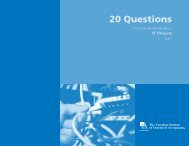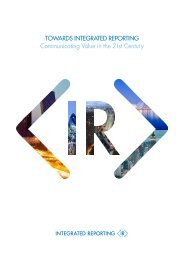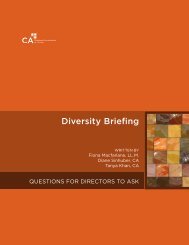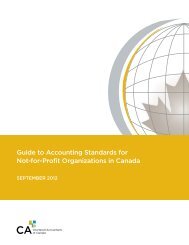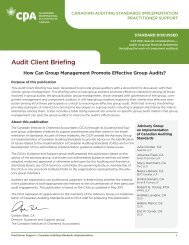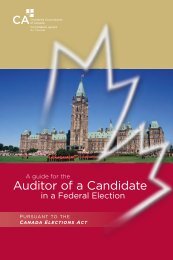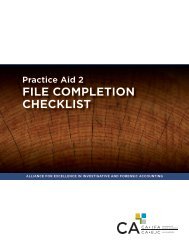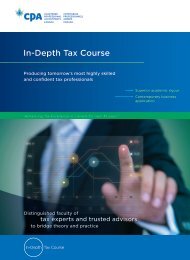2 0 questions - Canadian Institute of Chartered Accountants
2 0 questions - Canadian Institute of Chartered Accountants
2 0 questions - Canadian Institute of Chartered Accountants
You also want an ePaper? Increase the reach of your titles
YUMPU automatically turns print PDFs into web optimized ePapers that Google loves.
20 Questions Directors <strong>of</strong> Not-For-Pr<strong>of</strong>it OrganizationsShould Ask about Human ResourcesCompensation Red Flags:When reviewing the organization’s compensationphilosophy, the following indicators shouldtrigger extra review by the board:• Extensive use <strong>of</strong> discretion – in the setting<strong>of</strong> bonuses and other forms <strong>of</strong> compensation,or in the ability to override thecompensation guidelines.• Incenting undue risk-taking – pay structuresthat promise big payouts in returnfor achieving performance targets mayencourage excessive risk taking.• Undesirable risk exposures – pay elementsthat could put the organization at risk bytriggering large payouts (e.g., in the case <strong>of</strong>executive succession) or by damaging itsreputation in the eyes <strong>of</strong> stakeholders andthe public.8. How does the board set thecompensation <strong>of</strong> the Executive Director?In addition to approving the compensation philosophy<strong>of</strong> the entire organization, the board isresponsible for setting the compensation <strong>of</strong> theExecutive Director. While the board’s humanresources committee (if one exists) may domuch <strong>of</strong> the work and develop a recommendationregarding executive compensation, the finaldecision must be made by the full board. Largerorganizations may also consider the use <strong>of</strong> anindependent compensation consultant, althoughthis is not yet a common practice in the not-forpr<strong>of</strong>itsector.Elements that the board may consider whenreviewing the compensation <strong>of</strong> the ExecutiveDirector include:• Consistency with the overall compensationphilosophy – The ED’s compensation shouldfit within the same goals and guidelines thatgovern the compensation practices <strong>of</strong> theorganization as a whole.• External benchmarking and internal equity– The board may request information on howthe ED’s compensation compares with thatreceived by leaders <strong>of</strong> similar organizations,or how it relates to the compensation <strong>of</strong> otherswithin the organization.• Pay for performance – Where the ED’s compensationis tied to the achievement <strong>of</strong>specific goals, the board will need to reviewthe goals and ensure that they are appropriatein terms <strong>of</strong> achievability and also thatthere is an appropriate balance betweenshort-term and longer-term goals.• Talent retention – One <strong>of</strong> the main goals<strong>of</strong> executive compensation is to recruit andretain talented individuals to lead the organization.Direct monetary compensation shouldbe part <strong>of</strong> an overall package which may alsoinclude compensation in the form <strong>of</strong> healthand retirement benefits and non-financialbenefits such as working environment, pr<strong>of</strong>essionaldevelopment, etc. For organizationswhich are limited in their ability to providemonetary compensation, other types <strong>of</strong> benefitscan be an important means <strong>of</strong> recruitingand retaining leaders.Directors should ensure that they understand thedifferent elements <strong>of</strong> compensation packages,and that those obligations are properly capturedin the organization’s financial information.9. What is the board’s responsibilityfor the oversight <strong>of</strong> pensions?An employer is not required to provide any type<strong>of</strong> retirement savings program to its employees.However, many organizations choose to doso as part <strong>of</strong> their overall strategy to recruit andretain employees. There are two main types <strong>of</strong>employer-sponsored pension plans:• Defined benefit plan. The employer and/oremployee makes regular contributions overthe course <strong>of</strong> employment, and when theemployee has the requisite years <strong>of</strong> serviceand age to retire, the employee will receivea monthly benefit that is actuarially calculatedbased on years <strong>of</strong> service and earnings.The amount the employee receives is fixed,regardless <strong>of</strong> how well or poorly the pensioninvestment has performed, provided thatthe required funding levels have been maintained.• Defined contribution plan. This is similarto a group RRSP, in that the employee and/or employer contribute to the plan over theyears, but the amount the employee is entitledto receive on retirement is dependententirely on the performance <strong>of</strong> the fund. Theemployer may select a group <strong>of</strong> investmentfunds from which the employee can choose.9



